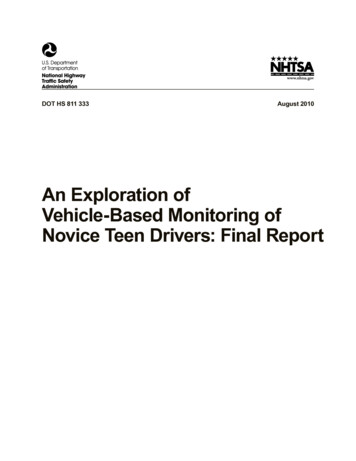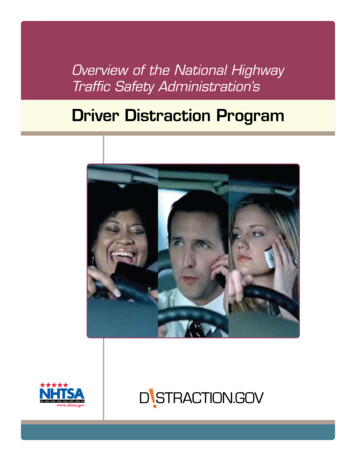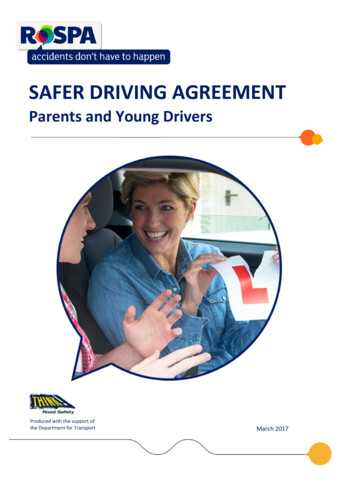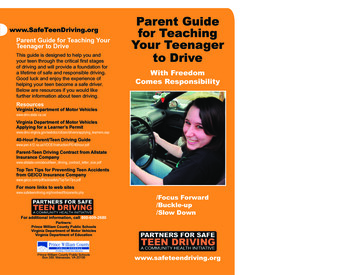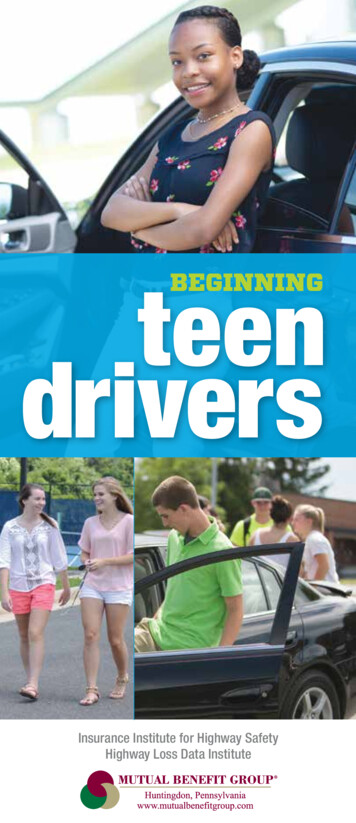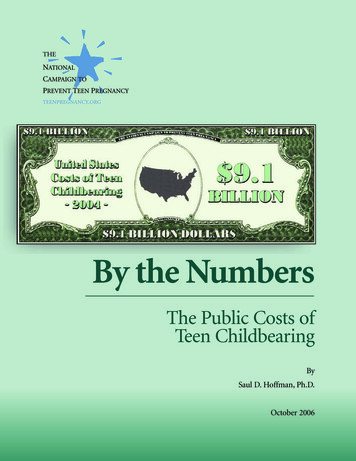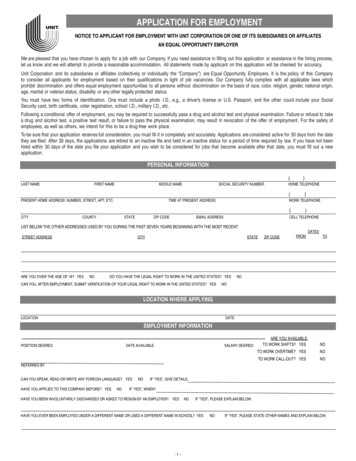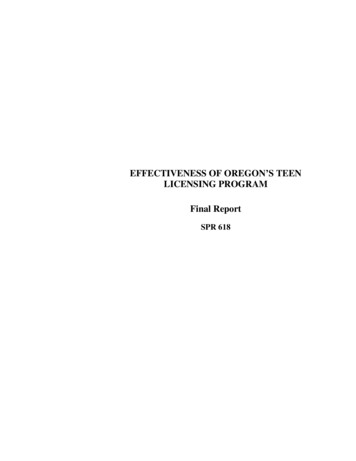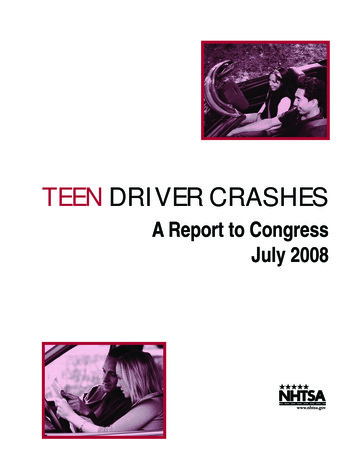
Transcription
TEEN DRIVER CRASHESA Report to CongressJuly 2008
Technical Report Documentation Page1. Report No.2. Government Accession No.3. Recipient's Catalog No.DOT HS 811 0054. Title and Subtitle5. Report DateJuly 2008Teen Driver Crashes: A Report to Congress6. Performing Organization CodeNTI-1308. Performing Organization Report No.7. Author(s)Richard P. Compton and Patricia Ellison-Potter10. Work Unit No. (TRAIS)9. Performing Organization Name and AddressOffice of Behavioral Safety ResearchNational Highway Traffic Safety Administration12. Sponsoring Agency Name and Address11. Contract or Grant No.13. Type of Report and Period CoveredNational Highway Traffic Safety AdministrationU.S. Department of Transportation1200 New Jersey Avenue SE.Washington, DC 20590Report to Congress14. Sponsoring Agency Code15. Supplementary Notes16. AbstractThis report summarizes what is known about the teen driver crash problem and reviews the research onthe major contributing factors to the high teen crash rate. Dispositional factors, such as immaturity,inexperience, faulty judgment, and a higher propensity for risk-taking all contribute to the teen drivercrash problem. Additionally, younger drivers are not experienced in hazard recognition. They do notgenerally acknowledge inherently dangerous situations on the road, and therefore do not reactappropriately. A brief review is included on a variety of programs designed to decrease teen drivercrashes, such as educational programs, laws and sanctions, and licensing programs. Scientificevaluations of these programs are discussed in terms of reducing the teen driver crash problem, therebymaking America’s roads safer for our youth.The study and report conclude with recommendations based on research for developing andimplementing interventions for this important traffic safety issue. Strong evidence supports thestrengthening of graduated driver licensing (GDL) laws in the States and incorporating driver educationinto the GDL system.17. Key Words18. Distribution StatementTeen driver crashes, driver education, graduated driverlicensing, risk-taking, hazard recognition.19. Security Classif.(of this report)UnclassifiedForm DOT F 1700.7 (8-72)20. Security Classif.(of this page)UnclassifiedReproduction of completed page authorizedDocument is available through theNational Technical Information ServiceSpringfield, VA 22161 and free of charge atwww.nhtsa.dot.gov.21. No. of Pages1222. Price
TEEN DRIVER CRASHESThe House Report (109-12 Section 2012) accompanying H.R. 3, Transportation Equity Act: ALegacy for Users, requested the Secretary to conduct a Teen Driver Study on the major causes oftraffic crashes involving teen drivers and evaluate existing teen driver programs. It went on torequest that the Secretary “transmit a report to the Committee on the results of the study andrecommendations to reduce the number of traffic crashes involving teenagers, includingrecommendations for model driving school curriculum and graduated licensing requirements.”This report documents the study’s findings and recommendations.Teen Driver CrashesMotor vehicle crashes are the leading cause of death for 15- to 20-year-olds. In 2006, 3,49015- to 20-year-old drivers died and an additional 272,000 were injured in motor vehicle crashes.In 2006, 12.9 percent of all the drivers involved in fatal crashes were between 15 and 20 yearsold. In comparison, these young drivers represent 6.3 percent of all licensed drivers. Overall,driver fatalities for this age group increased by 3 percent between 1996 and 2006. For youngmales, driver fatalities rose by 5 percent, compared with a 3 percent decrease for young females(NHTSA Traffic Safety Facts – Young Drivers, DOT HS 810 817, 2006).Figure 1 shows that in 2006 young drivers between 15 and 20 years old had the highest fatalcrash involvement rate of any age group with 59.5 fatal crashes per 100,000 licensed drivers.This rate is significantly higher than any other age group and more than double the rate for anyage group 35 and older.Figure 00 LicensedDrivers Involved in Fatal Crashes perLicensedDriversDrivers7059.560Number of 021-2425-3435-4445-54Age Group (Years)155-6465-6970
Figure 2 shows that in 2005 the involvement rate per 100,000 licensed drivers was highest(63.98) for 16-year-old drivers and lowest for 20-year-old drivers (53.52). Rates for 17- and 18year-old drivers are close to each other but are lower than the rate for 16-year-olds.80Figure 2Fatal Crash Involvement Rate by Driver Age per100,000 Licensed Drivers62.1958.7653.5220406055.990(Number of Drivers)Crash Involvement Rate63.98Age 16Age 17Age 18Age 19Age 20Contributing Factors to Teen Driver Crash RatesHighway safety literature has documented that teen drivers, due to a combination of immaturityand inexperience, have a higher propensity for risk-taking behaviors than do older and moreexperienced drivers. Research and crash data tell us that teen drivers are less likely to buckle up,and more likely to speed or drive too fast for prevailing conditions (Hedlund, Shults, &Compton, 2003). Other factors shown to place teen novice drivers at greater risk of crashinvolvement include driving late at night (Lin & Fearn, 2003), driving while impaired by alcohol(Williams, 2003), and driving in the presence of teenage passengers (Lin & Fearn, 2003;Williams, 2003). In fact, in-depth studies of novice-driver crashes suggest that contributingfactors to teen crashes are much the same as for adult experienced driver crashes.Teenagers appear to use new technology at a greater rate than older people do. The latest surveyof driver cell phone use found younger drivers ages 16-24 using hand-held cell phones at ahigher rate than older drivers (Traffic Safety Facts – Driver Cell Phone Use in 2006 – OverallResults, DOT HS 810 790, 2007). While younger drivers may not be more likely to use theirPersonal Digital Assistants (PDAs), iPods, and other portable entertainment devices whiledriving than older drivers, younger drivers are less experienced at multitasking while driving andare therefore more easily distracted than their older counterparts (Stutts et al., 2001). In fact,preliminary research has identified different visual scanning patterns between younger novicedrivers and older, more experienced drivers, providing support for teen drivers’ apparentinability to detect high-risk situations (Pradhan et al., 2005).2
Younger drivers are frequently inexperienced in hazard recognition and often take unnecessaryrisks due to a combination of poor decision making and an illusion of invulnerability (Williams,2006). Younger drivers do not always consider the consequences of their actions. Recentresearch in adolescent development supports the contention that younger people are oftendevelopmentally less capable of making sound judgments and decisions regarding potentiallyrisky behavior. Areas of the brain involved in rendering judgments and making decisions arenot fully developed until around age 25 (Keating, 2007).Young drivers are particularly vulnerable to certain high-risk driving situations, such as drivingat night (Lin & Fearn, 2003; Williams, 2003), after drinking alcohol (Williams, 2003), with otherteenage passengers (Lin & Fearn, 2003; Williams, 2003), and when unbelted (Ferguson, 2003).Programs to Reduce Teen Driver CrashesA variety of approaches have been taken to reduce teen driver crashes. These include laws andsanctions, licensing programs, and educational programs. These will be discussed briefly in turn.Laws and Sanctions – A number of laws that restrict teenage drinking and driving have beenshown to reduce teen crashes. Studies about raising the drinking age to 21 years old andenacting zero tolerance laws have been shown to reduce teen crash rates. Zero-tolerance lawsmake it unlawful for drivers under age 21 to operate vehicles with any detectable amount ofalcohol in their systems. All 50 States and the District of Columbia now have 21-year-oldminimum drinking age and zero-tolerance laws. NHTSA estimates that these laws have reducedtraffic fatalities involving drivers 18 to 20 years old by 13 percent and have saved an estimated25,509 lives since 1975. In 2006, minimum drinking age laws (NHTSA, 2006) saved anestimated 890 lives.In addition, States with primary seat belt laws (where a motorist can be stopped and ticketed fornot using a seat belt) have a 14-percentage-point higher use rate than States with weakerenforcement laws. This difference in use rate extends to teen drivers and passengers. Thus, theadoption of primary seat belt laws by all States would save many teen driver and passenger lives(NHTSA, 2007).Graduated Driver Licensing – Given the inexperience of novice drivers and evidence that withexperience novice driver crash rates decline fairly dramatically, people have sought ways toprovide novice drivers an opportunity to gain driving experience under less risky circumstances.This approach is known as graduated driver licensing (GDL), and has been shown by numerousstudies to be a highly effective method of reducing novice driver crash rates. NHTSArecommends a GDL program that involves a three-stage licensing system for beginning drivers(stage 1 learner’s permit; stage 2 provisional license; and stage 3 full license) that slowlyintroduces the young, novice driver to the driving task by controlling exposure to high-riskdriving situations (e.g., nighttime driving, driving with passengers, and driving after drinking anyamount of alcohol).3
The three stages of the GDL system include specific components and restrictions to introducedriving privileges gradually to beginning drivers. Novice drivers are required to demonstrateresponsible driving behavior during each stage of licensing before advancing to the next level.Each stage includes recommended components and restrictions for States to consider whenimplementing a GDL system. NHTSA currently recommends the following components andrestrictions for each stage:Stage 1: Learner's Permit State sets minimum age for a learner's permit at no younger than 16 years old; Pass vision and knowledge tests, including rules of the road, signs, and signals; Completion of basic driver training; Licensed adult (who is at least 21 years old) required in the vehicle at all times; All occupants must wear seat belts; Teenage passenger restrictions– not more than one teenage passenger for the first 12months of Intermediate License. Afterward, limit the number of teenage passengers totwo until age 18; Zero alcohol while driving; Learners permit is visually distinctive from other driver licenses; Must remain crash- and conviction-free, including violations of the seat belt, zerotolerance, speed, and other GDL provisions, for at least 6 consecutive months to advanceto the next level; Parental certification of 30 to 50 practice hours; and No use of portable electronic communication and entertainment devices while driving.Stage 2: Intermediate (Provisional) License Completion of Stage 1; State sets minimum age of 16.5 years old; Completion of intermediate driver education training (e.g., safe driving decision-making,risk education, etc.); All occupants must wear seat belts; Licensed adult required in the vehicle from 10 p.m. until 5 a.m. (e.g., night-time drivingrestriction) with limited exceptions (i.e., religious-, school-, medical-, or employmentrelated driving); Zero alcohol while driving; Driver improvement actions are initiated at lower point level than for regular drivers; Provisional license is visually distinctive from a regular license; Teenage passenger restrictions – not more than one teenage passenger for the first 12months of Intermediate License. Afterward, limit the number of teenage passengers totwo until age 18; Must remain crash- and conviction-free, including violations of the seat belt, zerotolerance, speed, and other GDL provisions, for at least 6 consecutive months to advanceto the next level; and No use of portable electronic communication and entertainment devices while driving.4
Stage 3: Full Licensure Completion of Stage 2; State sets minimum age of 18 for lifting of passenger and nighttime restrictions; Zero alcohol while driving; and Visually distinctive license for drivers under the age of 21.Evaluations clearly show the benefits of adopting GDL laws and GDL components. Florida’sGDL law resulted in a 9-percent reduction in crashes for drivers who were 16 and 17 years old(Ulmer et al., 2000).Ongoing research in Michigan (Shope et al., 2001) and North Carolina (Foss et al., 2001) hasshown a 26-percent and 25-percent reduction, respectively, in crashes involving 16-year-olddrivers. Maryland (Freidlander et al., under review), Texas (Willis, 2006), and Pennsylvania(Coben & McKay, 2003) GDL programs have shown similar success.Nova Scotia, Canada, reported a 29-percent reduction in crashes involving 16-year-old drivers(Mayhew et al., 2003), while a preliminary report from Ontario, Canada, cites a 31-percentreduction in crashes for all drivers 15 to 19 years old (Mayhew et al., 2002).Recently, NHTSA completed an evaluation of Georgia’s GDL (Teen and Adult DriverResponsibility Act, TADRA), and more recently of Oregon’s modified GDL program. Bothevaluations show unequivocal success in decreasing the teen crash rates in those jurisdictions.NHTSA also recently completed a study that compared States with passenger restriction laws fornovice teen drivers to States that do not have such passenger restrictions. The specific selectedStates include California, Massachusetts, and Virginia, and the results showed reduced teen crashrates in the targeted States due, at least in part, to the enactment of the passenger restriction laws.A NHTSA-supported study by Johns Hopkins University, released in June 2006, found thatStates that have comprehensive GDL programs had a 20-percent reduction in fatal crashesinvolving 16-year-old drivers. A comprehensive GDL program included at least five of thefollowing components: A minimum age of 15½ for obtaining a learner permit; A waiting period after obtaining a learner permit of at least 3 months before applying foran intermediate license; A minimum of 30 hours of supervised driving; Minimum age of at least 16 for obtaining an intermediate state license; Minimum age of at least 17 years for full licensing; A nighttime driving restriction; and A restriction on carrying passengers.As of September 2007, 46 States and the District of Columbia have enacted a 3-stage graduatedlicensing system for young novice drivers.1 Arkansas, Kansas, Minnesota and North Dakota donot yet have a 3-stage GDL program in place. NHTSA will continue to evaluate GDL on aState-by-State basis, and will assess the relative contribution of specific components within GDL(e.g., passenger restrictions, supervised driving).1As of June 2008, Minnesota has joined the States that have enacted a 3-stage GDL, totaling 47 States plus theDistrict of Columbia with a 3-stage GDL.5
Driver Education – It was once thought that effective driver education and training wouldreduce high crash rates of young, novice drivers. Historically, driver education in the UnitedStates has taught basic driving skills and safe driving practices. Many carefully conductedstudies of driver education in the United States and abroad have failed to provide evidence fordecreased crash rates among teen drivers who have participated in driver education programs(e.g., Jones, 1993; Mayhew & Simpson, 1996; Vernick et. al., 1999; Williams & Ferguson, 2004;Wynne-Jones & Hurst, 1985). Driver education remains a standard for acquiring driving skillsand 24 States require the completion of a driver education program before a person under the ageof 18 can apply for a license (IIHS, 2007).Traditional prelicensing driver education for novice drivers typically entails 30 hours ofclassroom instruction (theory, rules of the road, safe/defensive driving techniques, riskassessment), and 6 to 10 hours of in-vehicle training (vehicle control). While this may proveadequate for teaching basic vehicle control, it does not appear to result in long-term reduction incrash rates for novice drivers. Teens do not get into crashes because they are uninformed aboutthe basic rules of the road or safe driving practices; rather, studies show they are involved incrashes as a result of inexperience and risk-taking. Given this history of mixed results on theability of driver education to positively affect crash performance, it is unlikely that aneducational program alone, no matter how well designed and implemented, would result indramatic reductions in teen crash rates.In 2000, under a cooperative agreement, NHTSA contracted with the American Driver andTraffic Safety Education Association (ADTSEA) to produce driver education program standardson curricula, delivery, and outcomes. These standards were developed based on the bestthinking of 35 driver education experts assembled to consider what and how driver educationshould be taught. Based on these standards, ADTSEA also developed a detailed driver educationcurriculum. Seven States have adopted the ADTSEA standards, four States have adopted theADTSEA curriculum, and a many individual programs in other States have adopted or use partsof the ADTSEA curriculum (ADTSEA, 2007).In 2005, ADTSEA updated the standards and its accompanying curriculum, under a NHTSAcooperative agreement, to ensure the content kept pace with automotive technical advances.ADTSEA provides technical assistance to States and jurisdictions planning to implement orexpand driver education programs and graduated driver licensing requirements. (See theAppendix for details.)NHTSA is in the process of reviewing the current state of driver education in the United States.The U.S. Department of Education has joined with NHTSA in a review of current knowledgeand state-of-the-art instructional tools, training methods, and curricula consistent with identifiedbest teaching methodologies for teenagers. One component of this project will convene anexpert panel to determine the optimal sequencing and timing of the components of drivereducation training (classroom, in-vehicle, supervised driving). Given the lack of definitiveresearch and evaluation on many of these issues, it is possible the panel will not be able toclearly identify one “best” approach. In this case, NHTSA will assess the feasibility of movingforward with research to test alternative approaches to driver education to see if one approachproduces safer novice drivers.6
NHTSA also is exploring the development of consensus national guidelines for driver educationprogram content, delivery, and quality control. As part of the process to develop these guidelinesdriver education administrators and specialists from every State will be invited to a nationalconference in late 2008. The development of these guidelines will help to ensure that qualitydriver education is delivered and monitored uniformly throughout the country.7
CONCLUSIONS AND RECOMMENDATIONSThe available evidence shows that: Twenty-one-year-old minimum drinking age laws and zero-tolerance laws have beeneffective in reducing teen alcohol-related crashes. GDL programs have been shown to reduce teen crashes by approximately 20 percent. Primary seat belt laws lead to higher seat belt use among drivers and passengers ofall ages. Driver education is effective at ensuring that novice drivers know the rules of the road,learn basic vehicle control skills, and have been introduced to safe driving information.Near-term efforts to reduce teen crashes should focus on encouraging States to strengthen theirGDL laws to include provisions demonstrated to be effective in reducing teen crash rates. Thisincludes adopting a three-stage GDL system that incorporates a learner’s stage, a provisionallicense, and finally an unrestricted license. A strong GDL system should provide the novicedriver the opportunity to gain experience driving with a fully licensed adult driver under allconditions, including daytime and nighttime, adverse weather, high-speed roads, and congestedtraffic. The provisional license should contain the following restrictions, which have beenshown to reduce teen crashes: Restricted nighttime driving; Limiting the number of teenage passengers; Mandatory seat belt use; Zero tolerance for alcohol and drugs; and Delayed transition to an unrestricted license until the driver meets a minimum 1-yearperiod of violation-free driving.NHTSA’s Vehicle and Behavioral Safety Research Office has several ongoing projectsexamining the feasibility and potential of monitoring systems to encourage safer drivingbehavior by teens. One project is currently determining the specific driving behaviors thatshould be monitored to reduce risky driving by teens, including using data from naturalisticdriving to learn how novice teen driving behavior changes over the first 18 months of driving.Another study is looking at commercially available monitoring systems, coupled with weeklyfeedback to parents of teen drivers to reduce risky driving behavior and crashes. These projectsare still in formative stages, but may eventually result in systems for voluntary use by parentswho want to enhance the safety of their children as they learn to drive.In addition, NHTSA is examining a closer integration of driver education with graduated driverlicensing programs for novice drivers that would involve a multistage driver education program.For example, the first stage of such an integrated system might involve teaching novice driversthe rules of the road and basic vehicle control skills. Later, when the novice drivers progress tothe provisional license phase, they would be required to take a course that focuses on safedriving. Whether this approach would prove beneficial in reducing teen driver crashes remains tobe seen.8
REFERENCESAmerican Driver and Traffic Safety Education Association (ADTSEA), personalcommunication, September 2007.Coben, J. H., & McKay, M. P. (2003). Evaluation of the effectiveness of Pennsylvania’sgraduated driver licensing program. Harrisburg, PA: Pennsylvania Department ofTransportation.Ferguson, S. A. (2003). Other high-risk factors for young drivers - how graduated licensing does,doesn’t, or could address them. Journal of Safety Research, 34, 71-77.Foss, R., Feaganes, J. R., & Rodgman, E. A. (2001). Initial effects of graduated driver licensingon 16-year-old driver crashes in North Carolina. Journal of the American Medical Association,286(13), 1588-1592.Friedlander, B. R., Joyce, J. J., Kane, L. R., & Raleigh, R. L. (under review). Fatal and disablingyoung driver crashes in Maryland: Assessment of three years experience with graduatedlicensing for 16-year-olds.Hedlund, J. (2007). Novice teen driving: GDL and beyond. Journal of Safety Research, 38,259-266.Hedlund, J., Shultz, R., & Compton, R. (2003). What we know, what we don’t know, and whatwe need to know about graduated driver licensing. Journal of Safety Research, 34, 107-115.Insurance Institute for Highway Safety (September, 2007). U.S. Licensing Systems for YoungDrivers. Arlington, VA. xKeating, D. (2007). Understanding adolescent development: Implications for driving safety.Journal of Safety Research, 38, 147-157.Lin, M-L., & Fearn, K. T. (2003). The provisional license: nighttime and passenger restrictions -a literature review. Journal of Safety Research, 34, 51-61.Mayhew, D. R., Simpson, H. M., & Pak, A. (2002). Ontario graduated licensing systemevaluation-2002. Toronto, Canada: Ministry of Transportation.Mayhew, D. R., Simpson, H. M., Desmond, K., & Williams, A. F. (2003). Specific and longterm effects of Nova Scotia’s graduated licensing program. Traffic Injury Prevention, 4(2),91-97.Pradhan, A. K., Hammel, K. R., DeRamus, R., Pollatsek, A., Noyce, D. A., & Fisher, D. L.(2005). Using eye movement to evaluate effects of driver age on risk perception in a drivingsimulator. Human Factors, 47(4), 840-852.9
Shope, J. T., Molnar, L. J., Elliott, M. R., & Waller, P. F. (2001). Graduated driver licensing inMichigan: early impact on motor vehicle crashes among 16-year-old drivers. Journal of theAmerican Medical Association, 286(13), 1598-1599.Stutts, J. C., Reinfurt, D. W., Staplin, L. W., & Rodgman, E. A. (2001). The role of driverdistraction in traffic crashes. Washington, DC: AAA Foundation for Traffic Safety.Traffic Safety Facts: Young Drivers 2006 Data. NHTSA. DOT HS 810 817. Washington, DC:National Highway Traffic Safety Administration.Traffic Safety Facts: Seat Belt Use in 2007 – Overall Results. NHTSA. DOT HS 810 841.Washington, DC: National Highway Traffic Safety Administration.Ulmer, R. G., Preusser, D. F., Williams, A. F., Ferguson, S. A. & Farmer, C. M. (2000). Effectsof Florida’s graduated licensing program on the crash rate of teenage drivers. Accident Analysisand Prevention, 32(4), 527-532.Williams, A. F. (2003). Teenage drivers: patterns of risk. Journal of Safety Research, 34, 5-15.Williams, A. F. (2006). Young driver risk factors: successful and unsuccessful approaches fordealing with them and an agenda for the future. Injury Prevention, 12 (Supp), 14-18.10
APPENDIXTraffic Safety EducationLife Long Learning ProcessDriver Education 0Standards.pdfThe “Driver Education and In-Car Curriculum” was developed to provide current informationand techniques on teaching novice drivers the basics of motor vehicle operation. It wasdeveloped specifically to reference four textbooks:Drive Right, 10th edition, published by Prentice HallToday's Handbook Plus, 1999 edition, published by NTSA InternationalHow to Drive, 9th edition, published by the American Automobile AssociationResponsible Driving, 2006 edition, published by Glencoe/McGraw-HillIf a driver education program is using a textbook not listed above, the program will need tomatch the appropriate reading material of the text it is using in the “Resources” column of thecurriculum. It is recommended that each classroom instructor receive and use a copy of theteacher’s edition of one of the textbooks and that each student receive and use a copy of thetextbook while in the driver education program. The choice of text is left to the discretion ofeach individual school. Any of the four textbooks listed above will meet the requirements of aquality driver education program. Also, instructors and students should have a copy of theirState’s “Driver’s Handbook” for use in the program. The “Driver Education Classroom and InCar Curriculum” guide is divided into 10 units. These units will assist in the coordination of45 hours of classroom instruction. Also included are a Skills Log and an In-Car Guide. Eighthours of in-car instruction are grouped into the In-Car guide and alternate forms of the finalexam are provided along with unit exams.Package content:DVD Disc 1 - ADTSEA DVD Curriculum (includes over 1 hour of video)DVD Content (Audio/Video format)Unit 1 - Introduction to Novice Driver Responsibilities and the Licensing SystemUnit 2 - Introducing Operator and Vehicle Control Tasks in a Controlled EnvironmentUnit 3 - Space Management SystemUnit 4 - Basic Maneuvering TasksUnit 5 - Risk Reducing Strategies for High-Speed Multi-lane ExpresswaysUnit 6 - Personal Factors Influencing Operator PerformanceUnit 7 - Environmental Conditions That Affect Safe Vehicle OperationUnit 8 - Vehicle Functions and Malfunctions, and Collision ReportingUnit 9 - Sharing the Road With Commercial Motor VehiclesUnit 10 - Reducing the Influence of Distractions on the Driving TaskPC Content (PDF format, printable)Unit 1 - Introduction to Novice Driver Responsibilities and the Licensing SystemUnit 2 - Introducing Operator and Vehicle Control Tasks in a Controlled Environment11
Unit 3 - Space Management SystemUnit 4 - Basic Maneuvering TasksUnit 5 - Risk Reducing Strategies for High-Speed Multi-lane ExpresswaysUnit 6 - Personal Factors Influencing Operator PerformanceUnit 7 - Environmental Conditions That Affect Safe Vehicle OperationUnit 8 - Vehicle Functions and Malfunctions, and Collision ReportingUnit 9 - Sharing the Road With Commercial Motor VehiclesUnit 10 - Reducing the Influence of Distractions on the Driving TaskUnit Tests (1-10)Final Exam Form AFinal Exam Form BIn-car, Behind the Wheel LessonsParent Mentor Home Practice GuideDVD Disc 2 - AAA Foundation for Traffic Safety Videos (total video time: about 1 hour)"Using Your Eyes Effectively""Managing Space and Time""Freeway Driving""Sharing the Road"DVD Disc 3 - American Automobile Association (total video time: over ½ hour)"Teaching Your Teens to Drive"Lesson 1 - Developing Basic Vehicle ControlLesson 2 - Moving, Turning, Stopping and Securing the VehicleLesson 3 - Maneuvering in Light TrafficLesson 4 - Maneuvering in Moderate TrafficLesson 5 - Backing and Turning ManeuversLesson 6 - Assessing Highway ConditionsLesson 7 - Identifying Traffic Control DevicesLesson 8 - Searching for Clues to Motor Vehicle ConflictsLesson 9 - Searching for Clues From Non-Motorized Road UsersLesson 10 - Positioning and Timing at IntersectionsLesson 11 - Positioning and Timing When Following and Meeting Other VehiclesLesson 12 - Critical Time/Space DecisionsLesson 13 - Adverse Driving ConditionsAppendix - Parent-Teen ContractDVD Disc 4 - AAA Foundation for Traffic Safety (total video time: about 17 minutes)"Signs, Signals, and Marking, Understanding the Language of the Road"12
DOT HS 811 005July 2008
Teen driver crashes, driver education, graduated driver licensing, risk-taking, hazard recognition. 18. Distribution Statement Document is available through the National Technical Information Service Springfield, VA 22161 and free of charge at www.nhtsa.dot.gov. 19. Security Classif.(of this report) 20.
